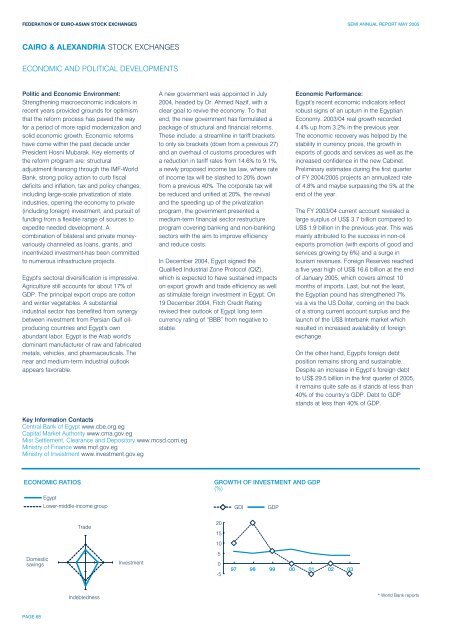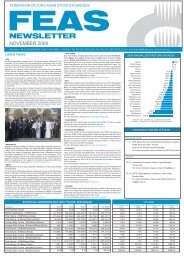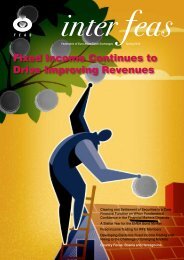Download - FEAS xxx.fh9
Download - FEAS xxx.fh9
Download - FEAS xxx.fh9
Create successful ePaper yourself
Turn your PDF publications into a flip-book with our unique Google optimized e-Paper software.
FEDERATION OF EURO-ASIAN STOCK EXCHANGES SEMI ANNUAL REPORT MAY 2005<br />
CAIRO & ALEXANDRIA STOCK EXCHANGES<br />
ECONOMIC AND POLITICAL DEVELOPMENTS<br />
Politic and Economic Environment:<br />
Strengthening macroeconomic indicators in<br />
recent years provided grounds for optimism<br />
that the reform process has paved the way<br />
for a period of more rapid modernization and<br />
solid economic growth. Economic reforms<br />
have come within the past decade under<br />
President Hosni Mubarak. Key elements of<br />
the reform program are: structural<br />
adjustment financing through the IMF-World<br />
Bank, strong policy action to curb fiscal<br />
deficits and inflation, tax and policy changes,<br />
including large-scale privatization of state<br />
industries, opening the economy to private<br />
(including foreign) investment, and pursuit of<br />
funding from a flexible range of sources to<br />
expedite needed development. A<br />
combination of bilateral and private moneyvariously<br />
channeled as loans, grants, and<br />
incentivized investment-has been committed<br />
to numerous infrastructure projects.<br />
Egypt's sectoral diversification is impressive.<br />
Agriculture still accounts for about 17% of<br />
GDP. The principal export crops are cotton<br />
and winter vegetables. A substantial<br />
industrial sector has benefited from synergy<br />
between investment from Persian Gulf oilproducing<br />
countries and Egypt's own<br />
abundant labor. Egypt is the Arab world's<br />
dominant manufacturer of raw and fabricated<br />
metals, vehicles, and pharmaceuticals. The<br />
near and medium-term industrial outlook<br />
appears favorable.<br />
Key Information Contacts<br />
Central Bank of Egypt www.cbe.org.eg<br />
Capital Market Authority www.cma.gov.eg<br />
Misr Settlement, Clearance and Depository www.mcsd.com.eg<br />
Ministry of Finance www.mof.gov.eg<br />
Ministry of Investment www.investment.gov.eg<br />
ECONOMIC RATIOS<br />
Domestic<br />
savings<br />
PAGE 68<br />
Egypt<br />
Lower-middle-income group<br />
Trade<br />
Indebtedness<br />
Investment<br />
A new government was appointed in July<br />
2004, headed by Dr. Ahmed Nazif, with a<br />
clear goal to revive the economy. To that<br />
end, the new government has formulated a<br />
package of structural and financial reforms.<br />
These include: a streamline in tariff brackets<br />
to only six brackets (down from a previous 27)<br />
and an overhaul of customs procedures with<br />
a reduction in tariff rates from 14.6% to 9.1%,<br />
a newly proposed income tax law, where rate<br />
of income tax will be slashed to 20% down<br />
from a previous 40%. The corporate tax will<br />
be reduced and unified at 20%, the revival<br />
and the speeding up of the privatization<br />
program, the government presented a<br />
medium-term financial sector restructure<br />
program covering banking and non-banking<br />
sectors with the aim to improve efficiency<br />
and reduce costs.<br />
In December 2004, Egypt signed the<br />
Qualified Industrial Zone Protocol (QIZ),<br />
which is expected to have sustained impacts<br />
on export growth and trade efficiency as well<br />
as stimulate foreign investment in Egypt. On<br />
19 December 2004, Fitch Credit Rating<br />
revised their outlook of Egypt long term<br />
currency rating of “BBB” from negative to<br />
stable.<br />
GROWTH OF INVESTMENT AND GDP<br />
(%)<br />
20<br />
15<br />
10<br />
5<br />
0<br />
-5<br />
97<br />
GDI GDP<br />
Economic Performance:<br />
Egypt's recent economic indicators reflect<br />
robust signs of an upturn in the Egyptian<br />
Economy. 2003/04 real growth recorded<br />
4.4% up from 3.2% in the previous year.<br />
The economic recovery was helped by the<br />
stability in currency prices, the growth in<br />
exports of goods and services as well as the<br />
increased confidence in the new Cabinet.<br />
Preliminary estimates during the first quarter<br />
of FY 2004/2005 projects an annualized rate<br />
of 4.8% and maybe surpassing the 5% at the<br />
end of the year.<br />
The FY 2003/04 current account revealed a<br />
large surplus of US$ 3.7 billion compared to<br />
US$ 1.9 billion in the previous year. This was<br />
mainly attributed to the success in non-oil<br />
exports promotion (with exports of good and<br />
services growing by 6%) and a surge in<br />
tourism revenues. Foreign Reserves reached<br />
a five year high of US$ 16.6 billion at the end<br />
of January 2005, which covers almost 10<br />
months of imports. Last, but not the least,<br />
the Egyptian pound has strengthened 7%<br />
vis a vis the US Dollar, coming on the back<br />
of a strong current account surplus and the<br />
launch of the US$ Interbank market which<br />
resulted in increased availability of foreign<br />
exchange.<br />
On the other hand, Egypt's foreign debt<br />
position remains strong and sustainable.<br />
Despite an increase in Egypt’s foreign debt<br />
to US$ 29.5 billion in the first quarter of 2005,<br />
it remains quite safe as it stands at less than<br />
40% of the country’s GDP. Debt to GDP<br />
stands at less than 40% of GDP.<br />
98 99 00 01 02 03<br />
* World Bank reports
















